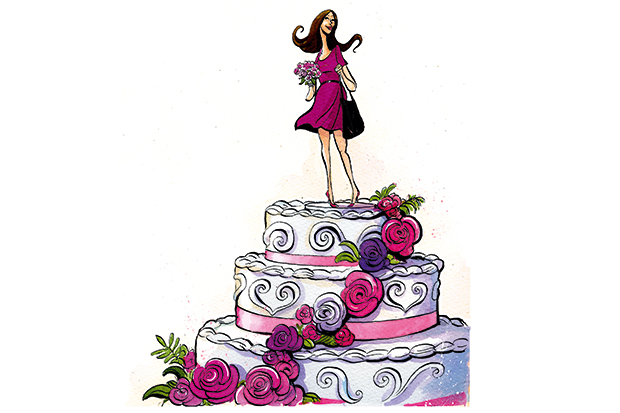As far as the bride was concerned, the wedding was perfect. Her dress was beautiful, the vows were traditional and she changed her name after the ceremony. The clifftop scenery was breathtaking, the seven bridesmaids were encouraging and supportive: move over Princess Di. There was only one thing missing: the groom. Like a growing number of single women, Sara Starkström had decided to marry herself.
‘I thought about people marrying other people without loving themselves first,’ says Starkström, a writer, explaining what many would call a bizarre overreaction to finding herself single at the age of 29. ‘How could they pledge to do all this stuff for another person when they couldn’t promise themselves the same thing? I decided to marry myself to celebrate my independence and strength. I did it to promise to be my own best friend.’
Though it wasn’t a legally binding ceremony (Starkström changed her surname using the Swedish equivalent of deed poll), the 36-year-old takes her married status seriously and, nearly seven years on from the wedding, still celebrates her anniversary: ‘Every year on the 9th of September I have to honour my vows, and really try to live up to the promises I made.’
But while this may all sound mad, narcissistic or completely pointless, self–marriage is one way to embrace the reality in which ever increasing numbers of women find themselves — wanting to settle down, have children and make a lifelong commitment, but being short of a man to do it with. Today there are more single people than at any previous time in history, especially in large cities. In America, where Beyoncé sang about ‘All The Single Ladies’, unmarried women now outnumber the married. In the UK, this happened ten years ago. Fewer women than ever want to become wives. Those aged between 25 and 44 are not even cohabiting — they are five times more likely to live by themselves today than they were in 1973 — and almost half of children are born out of wedlock. That figure is likely to expand massively in the next generation. The Marriage Foundation predicts that, of people in their twenties right now, only one in two will marry at all.
Marriage has been on the wane for some time. But what’s new is the decline in the number of women who are looking for a partner, let alone a husband. This is not a Bridget Jones-like tragic story. If we can’t find a knight in shining armour, we make alternative arrangements: the act of self-marrying is merely an extreme way of declaring that there is no hole in our lives.
In previous generations, we single ladies approaching or embracing middle age would have been called ‘spinsters’ and pitied by society at large. Now, societal expectations are evolving fast. Single women are not only challenging the prejudices against us: we are also creating our own support networks to replace traditional marriage, making fulfilling and self-sustaining arrangements with siblings, friends and flatmates, with whom we can share the intimate details of our lives. Single women may be technically alone, but we are not lonely.
Starkström may be Swedish, but self-marriage — or ‘sologamy’ as it is sometimes known — is not an exclusively Nordic phenomenon, although it is very new. The first account of a self-marriage I could find took place in the Netherlands in 2003 — the solo wedding of 30-year-old artist Jennifer Hoes. This may have been inspired by a Sex and the City episode that aired the same year, in which the show’s star single girl, Carrie Bradshaw, announces that she is marrying herself since she’s fed up of celebrating her married friends’ life choices and never her own. Whatever the catalyst for it, Hoes’s marriage generated a lot of publicity and seems to have started this baffling trend: since 2003, there have been multiple reports of single women marrying themselves in the UK, as well as in Australia, Canada, the Netherlands, Taiwan and the USA.
The practice appears to be particularly popular in Japan. Cerca Travel, a travel agency in Kyoto, offers a two-day ‘Solo Wedding’ trip for the comparatively inexpensive price of £2,500. The bride can enjoy dress fittings, choose her own bouquet with the help of a floral designer, have her hair and make-up done professionally, pose for a photoshoot and spend a night in a honeymoon suite in a luxury hotel. (Until recently, she could even choose her own fake groom, but not one woman took up this option, so the service was withdrawn.)
Only a handful of women are holding these eccentric ceremonies. But they are representative of a much wider group of women who have found fulfilment and stopped looking for a man. Sologamists are everywhere, even if that’s not how they describe themselves — you probably know a few.
So why aren’t they getting hitched? Perhaps the issue resides with their potential mates. For while it is true that marriage rates have declined in every category of earners, the decline is far starker among middle- and lower-income groups.
While it is likely that this decision not to marry is partly men’s as well as-women’s — a working paper from the National Bureau of Economic Research found that people get married when they feel they are financially ready and ‘marriageable’ — the ‘bread-winner hypothesis’ is still prevalent. Although women want to wed, they only want to marry a successful man with a secure job — and they will put off marriage until they find such a man, or until the man they are with is at that stage. The problem, particularly for women on lower incomes, is a lack of marriageable men. Economic trends — and the expansion of service jobs — have helped women, but the decline of manufacturing has hurt men, especially those who leave school aged 16. As they struggle to find their place in the economy, they also struggle to find a woman. The girls they went to school with take far better advantage of their opportunities, and feel little need to compromise.
The tendency of women not to marry low-earning men is not superficial or an indication that they are gold-diggers. Unlike previous generations, we are not under economic pressure to couple up — indeed, women in their twenties now out-earn their male counterparts — but we do require financial security if we are going to take a career break to start a family. Bringing up children is the one thing that is still a lot easier to do with a man around, in financial and practical terms, as well as in the obvious biological respect. Ideally, we’d all like to give our children two loving parents. But while single women can adopt, foster or use a sperm donor, it’s hard to support a family on a single income.
Many professional women find themselves in this predicament. Most of us want, or at least aspire, to ‘have it all’ — and that includes someone to love and share our lives with who, ideally, could support us if we take time out from our careers to have a family. By law, British women are entitled to take a year off for each baby. But though we receive 90 per cent of our average pre-tax weekly earnings for the first six weeks, this usually drops to £140 a week for the next 33 weeks, and dwindles to nothing at all for the remaining 13. We could really do with a partner’s financial support, and there are simply not enough ready and willing high-earning men to go around.
And so, if women can only ‘have most of it’, why shouldn’t that include ‘the big day’? Sologamists get to feel like a princess, surrounded by friends and family, and enact every non-legally-binding part of a wedding ceremony, including the photos and promises. They get the memories without the man, and the celebration with no fear of future acrimony. With 42 per cent of UK marriages currently ending in divorce, some might say self-marriage, or no marriage at all, is a more sensible option than conventional wedlock.
While many commentators make scathing judgments about sologamy (the feminist blog Jezebel ran a dismissive piece called ‘Single women, please stop marrying yourselves’, chiding, ‘You should be aware that you’re no trailblazer and you’re sure as hell not thumbing your nose at the system. You’re buying into it’), this hasn’t stopped increasing numbers of women from taking the plunge. For Starkström, self-marriage was a liberating act for which she is quite happy to take all the jokes ‘about me carry-ing myself over the threshold and making love to myself’.
Nor does every sologamist subscribe to the idea that their marriage is a placeholder for an unavailable man. DJ Maureen Schipper, a staunch feminist, considers it quite the opposite, and describes her plan to marry herself as a ‘significant step in my personal growth’. She explains: ‘Unpicking the prince on a white horse myth, untangling my emotional needs from what I was socialised to expect and no longer pining away for a man to make me whole was a lifetime’s work.’
The point is, settling down doesn’t mean the same thing as finding a partner. After being single for seven years, the artist Tracey Emin chose last May to marry a rock in the garden of her house in France. She said of her new partner, ‘It is beautiful and dignified, it will never let me down’ and referred to the stone as ‘an anchor — something I can identify with’. Instead of a wedding dress, she wore her father’s funeral shroud.
In India in 2006, a Hindu woman confessed that she had fallen in love with a snake. She subsequently married the snake in a Hindu ceremony. More than 2,000 people took part in the celebration, as they thought the wedding would bring good luck. The snake was not present, perhaps suffering from cold feet; a brass representation acted as a substitute.
In a similar case the previous year, a British woman sealed a 15-year-long affair with a dolphin in Israel, calling him ‘the love of my life’. After saying ‘I do’, she bestowed upon him a kiss and a herring. Yes, it sounds odd. As well as animals and a rock, there are accounts of single women flouting convention by marrying a sandwich in Las Vegas, a clay pot in Uttaranchal (when the bride’s fiancé was un-avoidably delayed on the big day) and a rollercoaster in Pennsylvania. The latter bride defended her decision by saying ‘I’m not hurting anyone.’
Perhaps this is the crux of the sologamy issue: self-marriage is harmless, cheap compared to the £20,500 average cost of a classic wedding, and the union seems to make the bride very happy. If only the same could be said for the majority of traditional marriages which feature a groom. Princess Diana’s fairy tale fell apart when she found that there were three people in her marriage. Now, for an ever-increasing number of determined modern women, one is more than enough.
The post Marriage for one appeared first on The Spectator.
Got something to add? Join the discussion and comment below.
Get 10 issues for just $10
Subscribe to The Spectator Australia today for the next 10 magazine issues, plus full online access, for just $10.
You might disagree with half of it, but you’ll enjoy reading all of it. Try your first month for free, then just $2 a week for the remainder of your first year.














Comments
Don't miss out
Join the conversation with other Spectator Australia readers. Subscribe to leave a comment.
SUBSCRIBEAlready a subscriber? Log in